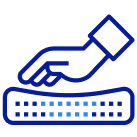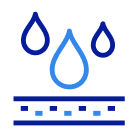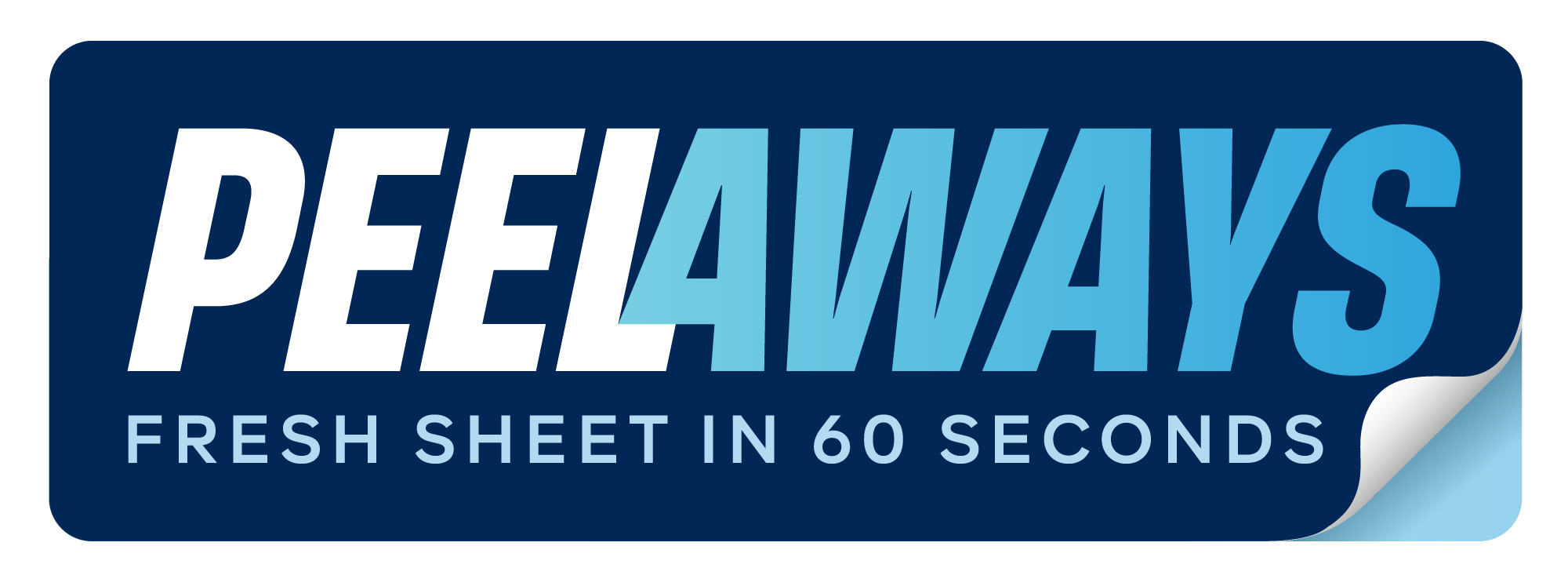Reducing Pathogen Spread: Cleaning Protocols Explained

Controlling the spread of pathogens in shared spaces is a major challenge, especially in healthcare and elder care settings. Bedding and high-touch surfaces are common sources of contamination, and traditional cleaning methods often fall short due to human error and time constraints. This article compares three cleaning approaches to help you choose the best solution for reducing cross-contamination:
- Manual cleaning and disinfection: Labor-intensive, prone to human error, and time-consuming, but essential for certain tasks.
- Disposable pre-impregnated wipes: Convenient and consistent but costly and limited by waste concerns.
- PeelAways multi-layer disposable sheets: A fast, easy bedding solution that minimizes handling and cross-contamination risks.
Each method has pros and cons depending on your environment, budget, and risk level. For high-risk settings, PeelAways offers a time-saving and effective way to manage contaminated bedding without requiring extensive training or laundry facilities. Below, we explore these options in detail to help you make an informed decision.
Environmental Cleaning and Disinfection in the Healthcare Setting - 2024 IP Boot Camp
1. Manual Cleaning and Disinfection
Manual cleaning and disinfection is the long-standing method used to control pathogens in healthcare and elder care settings. This process relies on staff physically cleaning surfaces, equipment, and bedding. While it's a common practice, it has notable challenges that can limit its effectiveness, especially in environments where infection control is critical.
Effectiveness
The success of manual cleaning depends entirely on human performance, and studies highlight significant shortcomings. For example, research reveals that only 1.4% of endoscopes cleaned using manual methods were properly cleaned at every step. Most errors occurred during the manual cleaning phase [3]. This shows how human error can severely impact outcomes.
Inconsistent adherence to cleaning protocols is another issue. Staff working under time pressure often rush, leading to reduced disinfectant contact times or skipped steps. The physical demands of manual cleaning, combined with fatigue, further increase the risk of mistakes.
Disinfectant contact time is crucial for killing pathogens, ranging from 15 seconds to as long as 30 minutes, depending on the chemical and the targeted microorganism [2][4]. However, maintaining these times consistently during manual cleaning is difficult in real-world conditions, especially in busy healthcare settings.
Labor and Time Requirements
Manual cleaning is labor-intensive and requires significant time and resources. Laboratory protocols suggest cleaning takes an average of 14-25 minutes per session, but in clinical settings, the time allocated is often just 4-7 minutes [3]. This gap suggests that clinical cleaning is frequently rushed, potentially compromising thoroughness.
High-risk areas like operating rooms, ICUs, and emergency departments need frequent cleaning - sometimes multiple times a day or before and after every procedure [1]. This creates a demanding schedule that requires clear role division between general cleaning staff and clinical personnel such as nurses and assistants.
The physical nature of manual cleaning takes a toll on workers. Repetitive motions, handling various chemicals, and maintaining focus over extended periods can lead to fatigue and discomfort. These physical and time constraints often lead to higher costs and reduced effectiveness in maintaining cleanliness.
Cost
Manual cleaning comes with hidden expenses beyond the obvious. Errors in cleaning can lead to infections, which increase healthcare costs. Additionally, facilities must invest in ongoing staff training to ensure everyone understands complex cleaning protocols for different surfaces and equipment.
Administrative overhead also adds to the expense. Facilities need detailed cleaning schedules, checklists, and Standard Operating Procedures to ensure consistency [1]. The physical demands of the job can lead to higher staff turnover and more sick leave, further driving up costs.
Chemical expenses accumulate over time as well. Different pathogens and surfaces require various disinfectants, which need proper storage and have expiration dates. Managing these inventories adds complexity and cost, making manual cleaning less reliable in environments where pathogen control is critical.
Suitability for High-Risk Environments
Manual cleaning's variability makes it less reliable in high-risk areas. These environments demand strict adherence to detailed procedures, but the complexity and tedious nature of manual protocols often lead to lapses [3]. Shared responsibilities between cleaning staff and clinical personnel can also create accountability gaps, especially during busy shifts or staff changes.
Another issue is the lack of standardization across healthcare facilities. Staff moving between locations may encounter different protocols for the same tasks, which undermines consistency [3]. This variability poses a challenge for environments that require dependable pathogen control.
Despite these drawbacks, manual cleaning remains essential for certain specialized equipment and situations where automated cleaning isn't an option. To improve reliability, many facilities now rely on checklists and job aids to reduce human error, particularly for high-touch surfaces that carry the highest risk of contamination [1].
2. Disposable Pre-Impregnated Wipes
Disposable pre-impregnated wipes have become a go-to solution in healthcare for standardized cleaning. By offering pre-soaked disinfectant in a single-use format, they help reduce inconsistencies compared to manual methods. However, like any tool, they come with both strengths and drawbacks. Let’s take a closer look at how their formulation impacts cleaning performance.
Effectiveness
One major advantage of pre-impregnated wipes is their consistent chemical concentration. Each wipe is pre-soaked with the right amount of disinfectant, eliminating the need for staff to mix solutions on-site. This ensures that surfaces receive the proper amount of active ingredients to help reduce pathogen transmission. However, their effectiveness depends on correct usage - proper wiping technique and ensuring the disinfectant stays on the surface long enough to work are key.
That said, there’s a downside: cross-contamination. If the same wipe is used on multiple surfaces, especially in high-touch areas like door handles, bed rails, or medical equipment, pathogens can be transferred instead of eliminated. Improper storage, such as leaving containers open, can also lead to moisture loss, which reduces the wipes’ disinfecting power.
Labor and Time Requirements
When it comes to saving time, pre-impregnated wipes shine. Staff don’t have to spend time preparing disinfectant solutions, which is a big advantage in busy healthcare environments. Their portability also makes it easier for cleaning teams to move quickly from one area to another. Plus, the simplified process reduces training time and minimizes errors related to solution preparation. Managing these wipes is straightforward, too - keeping pre-packaged wipes stocked and ready is far simpler than dealing with bulk disinfectants.
Cost
While pre-impregnated wipes come with higher upfront costs, they can save money on labor by streamlining the cleaning process. However, there are trade-offs. Disposable wipes generate more waste compared to reusable cleaning cloths, which can lead to higher disposal costs and environmental concerns. They also require more storage space and have shorter shelf lives than concentrated disinfectants, potentially adding to storage and replacement costs.
Suitability for High-Risk Environments
In areas where controlling pathogen spread is critical, such as operating rooms, intensive care units, or isolation rooms, pre-impregnated wipes can play a role - but they’re not always enough on their own. While their single-use design helps reduce cross-contamination when used properly, reusing a wipe across multiple surfaces can undermine this benefit. In high-risk environments, these wipes are often used alongside more rigorous cleaning protocols. Additionally, their limited coverage means multiple wipes may be needed for thorough cleaning, which increases both costs and waste.
sbb-itb-45288fe
3. PeelAways Multi-Layer Disposable Sheets
PeelAways sheets are designed to keep contaminants from reaching the surface below. Thanks to their patented multi-layer structure, which includes 5 to 7 soft, absorbent layers (with larger sizes like Cot and Twin XL featuring 7 layers), you can simply peel away the top layer when it becomes soiled. Underneath, you'll find a clean, waterproof barrier ready for use. This design reduces the risk of cross-contamination compared to traditional linens, which require more handling and cleaning.
Effectiveness
The real strength of PeelAways lies in how effectively it traps contaminants in the removed top layer. The 100% waterproof barrier ensures no liquids seep through to the lower layers or mattress, maintaining the integrity of each layer. Plus, the breathable fabric balances comfort with infection control, making it a practical choice for environments where hygiene is critical.
Labor and Time Savings
Changing traditional linens often involves repositioning patients, removing and replacing sheets, and cleaning the mattress underneath - tasks that can be time-consuming and labor-intensive. PeelAways simplifies this process. Caregivers can easily peel off the soiled layer without lifting the patient or dealing with bulky, dirty linens. This quick, single-step method frees up time and allows staff to focus on patient care instead of laundry.
Cost
PeelAways offers a practical balance between price and convenience. Here’s a breakdown of their pricing:
- Twin (5 layers): $34.99
- Queen: $47.99
- King: $53.99
- 7-layer Twin XL: $41.99
In addition to reducing laundry expenses, PeelAways offers a 15% subscription discount and a 30-day money-back guarantee, making it a cost-effective choice for many settings.
Ideal for High-Risk Environments
PeelAways is a smart solution for places that demand strict infection control, such as intensive care units, isolation rooms, and recovery wards. Its chemical-free design is gentle for patients with sensitivities, while its physical containment of contaminants reduces the risk of spreading pathogens. By minimizing the handling of soiled materials, it supports safer practices. Plus, with compostable and biodegradable options available, PeelAways also aligns with environmentally conscious practices. In emergencies or disease outbreaks, the ability to quickly manage contaminated bedding without needing laundry facilities or extensive staff training makes it an invaluable tool for infection control.
Advantages and Disadvantages
Expanding on the earlier analysis of cleaning protocols, let’s dive into their specific benefits and challenges, particularly in healthcare and elder care settings. Each method has unique strengths and limitations, which can influence its suitability depending on the situation.
Here’s a breakdown of the key points:
| Method | Advantages | Disadvantages | Best Suited For |
|---|---|---|---|
| Manual Cleaning and Disinfection | • Full control over cleaning steps • Cost-effective for smaller spaces • Relies on familiar tools and supplies • Enables detailed inspections during cleaning |
• Time-consuming and labor-intensive • Prone to human error in technique • Risk of cross-contamination • Requires significant staff training |
Small facilities, low-traffic areas, and operations with tight budgets |
| Disposable Pre-Impregnated Wipes | • Convenient and fast to use • Ensures consistent chemical application • Cuts down preparation time • Portable for quick cleanups |
• Higher recurring expenses • Environmental concerns due to waste • Limited coverage per wipe • Risk of drying out if improperly stored |
Emergency cleanups, portable cleaning needs, and rapid disinfection tasks |
| PeelAways Multi-Layer Sheets | • Eliminates cross-contamination risks • Saves significant time with a simple process • Provides a waterproof barrier • Chemical-free and gentle on skin • Subscription discounts (15% off) available |
• Higher initial cost ($30.99–$53.99) • Single-use design contributes to waste • Limited to bedding applications • Requires purchasing multiple sizes |
Healthcare facilities, elder care, special needs care, and high-risk patient environments |
Additional Considerations
Manual cleaning often involves recurring expenses for supplies, equipment upkeep, and labor. On the other hand, PeelAways offers subscription discounts that make it a scalable option for larger facilities. Environmental impact also varies - manual cleaning generates wastewater and chemical disposal issues, disposable wipes add to landfill waste, while PeelAways provides compostable and biodegradable alternatives.
When it comes to infection control, execution is critical. Manual cleaning depends heavily on staff consistency, disposable wipes can miss areas if not used properly, and PeelAways minimizes contamination risks by eliminating direct handling of pathogens. PeelAways also requires far less training compared to the extensive protocols needed for manual cleaning.
Facility size is another key factor. As operations expand, manual cleaning becomes more labor-intensive and costly, while PeelAways’ subscription model helps manage costs efficiently. In scenarios like disease outbreaks or staffing shortages, traditional cleaning methods often struggle due to time and personnel constraints. PeelAways, however, simplifies the process and ensures reliable pathogen control, even under challenging conditions.
Conclusion
Selecting the right cleaning method comes down to understanding your environment, budget, and the level of contamination risk. For smaller facilities with limited cleaning needs, manual cleaning might suffice, though it comes with the risk of cross-contamination. On the other hand, disposable pre-impregnated wipes are a great option for quick, portable cleaning - especially in emergencies - but their recurring costs can add up in larger facilities.
For environments with higher contamination risks, like healthcare settings or elder care centers, PeelAways multi-layer disposable sheets provide a practical solution. These sheets feature a waterproof barrier and a design that minimizes cross-contamination, helping to maintain patient safety. Plus, the 15% subscription discount helps manage ongoing costs.
Ultimately, the most important factor is how well the cleaning protocol controls infections. PeelAways sheets simplify infection control by reducing the chances of human error, offering a ready-to-use solution that’s especially valuable in high-risk areas where safety is critical.
When deciding on a cleaning approach, consider factors like patient volume, staffing levels, budget, and risk of contamination. In many healthcare and elder care settings, a combination of PeelAways for bedding and disinfecting wipes for surfaces can provide a well-rounded strategy to control pathogens while staying cost-effective.
FAQs
How do PeelAways disposable sheets help prevent the spread of pathogens in shared spaces?
PeelAways disposable sheets offer a practical solution for reducing the spread of pathogens by providing a fresh, clean layer every time. Thanks to their multi-layer design, you can peel off the soiled top layer to instantly reveal a new, hygienic one beneath. This clever approach eliminates the need to handle or wash contaminated linens, cutting down on the risk of spreading germs and reducing cross-contamination concerns.
Unlike traditional bedding, PeelAways sheets limit exposure to soiled materials while offering a fast, stress-free way to maintain cleanliness. They’re particularly valuable in settings like healthcare facilities, elder care, and other shared environments where keeping things sanitary is a top priority.
What environmental impacts do disposable cleaning wipes have, and how can they affect cleaning costs?
Disposable cleaning wipes may seem convenient, but they come with a hefty downside for the environment. They contribute to microplastic pollution, clog sewer systems, and pile up in landfills where they can take decades - or even longer - to break down. These issues don't just harm ecosystems; they also drive up costs for sewer repairs, waste management, and environmental cleanup.
Switching to eco-friendly or biodegradable wipes is a smarter choice. For instance, bio-based wipes cause far less harm throughout their lifecycle compared to their petroleum-based counterparts. By choosing these sustainable alternatives, you're not just helping the planet - you could also save money in the long run by reducing waste and cutting back on maintenance expenses.
Why is manual cleaning often less reliable in high-risk healthcare settings, even though it may be cost-effective for smaller areas?
In high-risk healthcare settings, manual cleaning often struggles to meet the mark due to issues like uneven thoroughness, human error, and staff fatigue. These factors can result in incomplete disinfection, which increases the likelihood of pathogen transmission.
To address these challenges, automated cleaning systems and monitoring technologies are gaining traction. They deliver consistent, effective results and help minimize the risk of cross-contamination. While manual cleaning may suffice for smaller spaces, it frequently falls short of the strict hygiene standards demanded in healthcare environments.
Related Blog Posts
- 5 Steps for Handling Contaminated Linens Safely
- Checklist for Infection Control in Shared Living Spaces
- How Disposable Sheets Reduce Cross-Contamination
- Best Practices for Energy-Efficient Ventilation in Care Facilities
Comments
0

SAVE MONEY & WATER
Professionals & Institutions save a fortune on labor/laundry.

SUPERIOR COMFORT
The first thing our customers notice is how soft our sheets are.

100% WATERPROOF
Each layer is 100% Waterproof, perfect for spills and accidents

SAVE TIME
Change the sheet in under 1 minute without stripping the bed.




Leave a comment